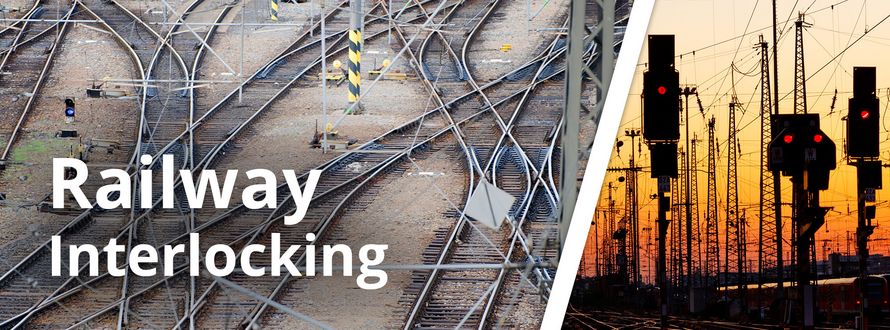
Interlocking in the Railway Sector
– RailwayInterlocking is a crucial component in the Railway sector, ensuring the safety and efficiency of train movements. An interlocking system is an arrangement of signal apparatus that prevents conflicting movements through an arrangement of tracks such as junctions or crossings. It ensures that trains move safely through stations by managing tracks, points, and signals:
- Tracks: Straight paths that guide trains.
- Points: Crossing paths that enable a change of direction, consisting of a combination of straight and curved lines.
- Signals: Equipment positioned beside the Railway to indicate to train drivers whether they should stop or proceed.
Trains move forward through stations according to predefined itineraries. An itinerary is a set of ordered line elements (tracks and points). Each element must be set before being occupied by a train. Once the train leaves the element, it is first released and then reset for the next train. This process ensures that only one train occupies a specific section of track at any given time, preventing collisions and ensuring efficient traffic flow.
Challenges in Interlocking Systems
Interlocking systems face several challenges that need to be addressed to maintain safety and efficiency:
- Complexity of Requirements, Risks, and Hazards Elicitation:
Accurately identifying and managing requirements, risks, and hazards is critical to the safety and reliability of interlocking systems. - Seamless Modelling Approach:
From the system level down to software components, ensuring a seamless modelling approach is essential for effective system design and integration. - Interfaces Consistency:
Ensuring consistency in interfaces, from Interface Control Documents (ICD) to components interfaces and data, is crucial for system interoperability. - Automated Documentation:
Generating and maintaining accurate and up-to-date documentation is vital for system maintenance and regulatory compliance. - Complete Traceability Management:
Enabling complete traceability management to facilitate impact and non-regression analyses. - Verification and Certification Optimization:
Optimizing verification through static analysis, simulation, and testing, as well as ensuring certification using qualified and certified tools.
Key Aspects for enhanced Safety and Reliability
To further enhance the Safety and reliability of interlocking systems, additional critical aspects must be incorporated into their design and operation.
- Fail-Safe Design:
Each unit within the interlocking system must be fail-safe. This means that in the event of a failure, the system defaults to a safe state, preventing accidents and ensuring continuous protection. Fail-safe design principles are integral to maintaining the highest levels of safety in railway operations. - Subsystem Monitoring:
Subsystems within the interlocking system continuously monitor each other to detect and respond to any malfunctions. This monitoring ensures that issues are identified and addressed promptly, preventing minor problems from escalating into major safety concerns. - Motor and Software Malfunction Detection:
Motors that operate points and signals must be regularly inspected for malfunctions. Detecting and addressing hardware and software issues is crucial to maintaining the integrity and reliability of the interlocking system. Advanced diagnostic tools and regular maintenance schedules help ensure that all hardware and software components function correctly and efficiently.
Additional Considerations
- Redundancy:
Implementing redundant systems can ensure that if one component fails, another can take over, thereby maintaining uninterrupted operation. - Predictive Maintenance:
Utilizing advanced analytics and machine learning to predict potential failures before they occur can further prevent downtime and improve system reliability. - Cybersecurity Measures:
Enhancing cybersecurity to protect interlocking systems from malicious attacks is crucial in an increasingly digital and connected railway infrastructure. - Compliance with Standards:
Ensuring compliance with international Safety and reliability standards (e.g., IEC 62443 for Industrial Cybersecurity) guarantees that systems meet stringent safety and security requirements. - Environmental Considerations:
Designing systems to withstand various environmental conditions, such as extreme weather, can enhance reliability and longevity.
SYSGO's Solutions for Interlocking Systems
SYSGO offers a suite of solutions designed to tackle the challenges of interlocking systems in the Railway sector. These solutions enhance safety, reliability, and efficiency through advanced technology and comprehensive system management, with a particular focus on the PikeOS RTOS and Hypervisor and achieving EN 50128 Safety certification.
Requirements, Risks, and Hazards Elicitation
SYSGO provides tools within the PikeOS platform that facilitate the accurate identification and management of requirements, risks, and hazards. PikeOS supports strict partitioning, which allows different Safety levels to be managed within the same system, ensuring that all potential issues are addressed early in the system design process, enhancing overall Safety and reliability.
Seamless Modelling Approach
PikeOS supports a seamless modelling approach from the system level down to individual software components. This integration ensures that all parts of the interlocking system work together harmoniously, reducing the risk of errors and improving overall system performance. PikeOS's hypervisor capabilities enable running multiple guest operating systems and applications such as Linux, ELinOS, Windows, Android and many more concurrently on the same hardware, optimizing resource usage and ensuring real-time performance.
Interfaces Consistency
Ensuring interfaces consistency is crucial for maintaining interoperability between different parts of the interlocking system. PikeOS provides a well-defined and standardized set of interfaces, from Interface Control Documents (ICDs) to components interfaces and data, ensuring smooth and efficient operations.
Automated Documentation
PikeOS includes tools that support largely automated documentation generation. This reduces the time and effort required to produce and maintain accurate documentation, ensuring that all documentation is up-to-date and compliant with regulatory requirements, specifically addressing the stringent demands of EN 50128.
Complete Traceability Management
SYSGO provides comprehensive traceability management tools that enable complete tracking of all system elements within PikeOS. This traceability is essential for conducting impact and non-regression analyses, ensuring that changes to the system do not introduce new issues. PikeOS supports full traceability from requirements through to code and tests, facilitating rigorous validation and verification processes.
Verification and Certification Optimization
PikeOS includes advanced tools for optimizing verification through static analysis, simulation, and testing. Additionally, SYSGO provides qualified and certified tools that streamline the certification process, ensuring that interlocking systems meet all regulatory requirements. PikeOS is certified to the highest safety standards, including EN 50128 SIL 4 (Safety Integrity Level), making it an ideal choice for Safety-critical Railway applications.
Security Certification
PikeOS is designed with Security as a foundational element. It offers robust Security features that are critical for Railway interlocking systems:
- Secure Partitioning:
PikeOS uses secure partitioning to isolate different applications and processes. This ensures that a fault or Security breach in one partition does not affect other partitions, maintaining system integrity and availability. - Access Control:
PikeOS provides comprehensive access control mechanisms to prevent unauthorized access to critical system functions and data. - Data Integrity:
The platform ensures data integrity through secure communication protocols and cryptographic functions, protecting data both at rest and in transit.
PikeOS is certified against the Common Criteria EAL5+ for information technology security evaluation, an international standard for computer Security certification. This certification attests to the robust security features of PikeOS and its suitability for deployment in Security-sensitive environments.
Conclusion
Interlocking systems are vital to the safe and efficient operation of Railway networks. By addressing the challenges of complexity, consistency, documentation, traceability, verification, and certification, SYSGO's PikeOS RTOS and Hypervisor enhances the Safety and reliability of these systems. Through advanced technology and comprehensive system management, SYSGO ensures that Railway interlocking systems operate at peak efficiency, providing safe and reliable transportation for all passengers.
Looking ahead, the future of Railway interlocking systems promises even greater advancements in Safety, efficiency, and reliability. The integration of Artificial Intelligence (AI) and Machine Learning (ML) could revolutionize predictive maintenance, allowing systems to anticipate and address potential failures before they occur, thus minimizing downtime and enhancing overall reliability. Moreover, the development of more resilient and adaptive interlocking systems will be crucial in addressing the growing complexities of modern railway networks. Innovations in sensor technology and real-time data analytics can provide more accurate and timely information, enabling better decision-making and more responsive control mechanisms.
The increasing digitization and connectivity of railway systems also highlight the need for robust Cybersecurity measures. Future interlocking systems will need to incorporate advanced Security protocols to protect against emerging cyber threats, ensuring the integrity and Safety of Railway operations in an increasingly connected world.
And finally, environmental considerations will play a larger role in the design and implementation of interlocking systems. Future systems will need to be more adaptable to extreme weather conditions and other environmental challenges, ensuring consistent performance and longevity.
More information at www.sysgo.com/pikeos
-
Previous
-
Next

 Twitter
Twitter LinkedIn
LinkedIn Facebook
Facebook Pocket
Pocket RSS
RSS
